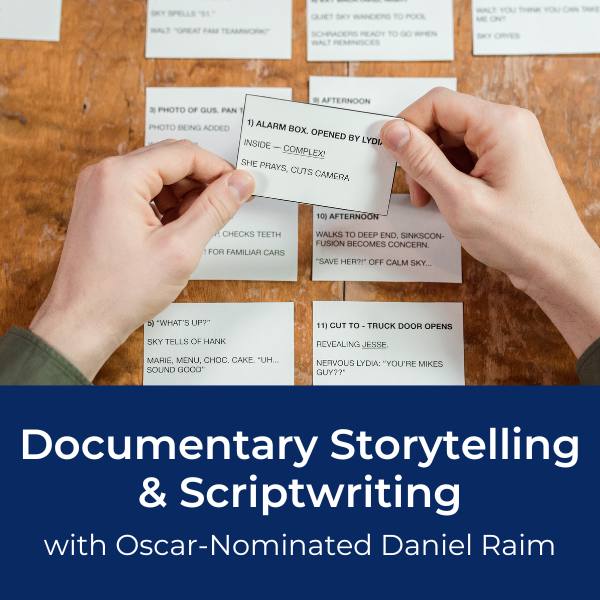8 Mistakes: Why Your Documentary Isn't Any Good
8 Common Amateur Mistakes To Avoid
When Making Your Documentary
Wondering why your documentary isn't any good?
Have you edited together a rough cut and the story is turning out boring and uninteresting?
Are you wondering if you should just toss out all your footage and start over?
Not so fast! You might just be missing a few key storytelling basics that can get you back on track.
Documentary Courses & Templates:
8 Mistakes: Why Your Documentary Isn't Any Good
Here are some common amateur storytelling mistakes to avoid when making a documentary:
Mistake #1. Nothing Unique About The Story
“Been there, done that” - No compelling hook or unique angle to the story. It’s okay if the topic/issue has been reported on before (climate change, gun control, autism, racism, etc) but make sure there’s a new twist to the story.
Mistake #2. Monotone Story Structure
Where are the ups and downs? Where’s the climax? Where’s the building of tension? Where’s the “roller coaster ride” of emotion, intrigue and mystery? Your audience should be asking "what's going to happen next?".
Mistake #3. One Dimensional Characters
Your characters aren't interesting (or they don’t SEEM interesting) – What about your character(s) will cause your audience to be intrigued or care about them?
How can you reveal their lives so that the audience is more invested in what happens to them?
Are you only showing their good side and successes? Or are you willing to reveal their weaknesses, downsides and struggles?
HINT: The way to create more interesting characters is to discover the primary desire of your main character and what’s standing in the way of them getting it. That’s the tension! Your film sets up the question of whether they can overcome the various obstacles to achieve their dream. The audience is then rooting for your main character and they care what happens to them.
Mistake #4. No Core Question
There should be one core question in the viewer's mind that keeps them glued to the screen to find out how it ends.
Examples of core questions: "Will they make it up that mountain?" "Will she win the election?" "Will they reconcile?" "Will they make it out alive?"
If an audience is curious about the core question, they won't want to stop watching the movie until they find out what happens!
Mistake #5. Preachy
There are no unanswered questions to keep the audience guessing. The film is not allowing the viewer to explore and discover the story on their own.
Mistake #6. Lack of Conflict
Where in your story is the conflict or tension?
Don’t be fooled by this one as conflict doesn’t necessarily need to be two people fighting. It can be an internal conflict or a battle with time or nature.
Mistake #7. Topic/Issue Focused vs. Human Heart
A common amateur mistake is to focus on an “issue” rather than the “people” involved in that issue.
A more compelling method of storytelling is to find a great “human” story, the HEART, within the bigger issue.
By making your audience care about your character and become invested in their struggle, they will learn about and care about the bigger issue.
Mistake #8. Bad Quality Audio
If the story is amazing and well told, an audience will forgive sub-par visuals (grainy footage, bad lighting, etc), but bad audio will kill even the best story.
Any audio that is aggravating to listen to --indecipherable, crackly, etc -- will cause the viewer to turn away and tune out. No matter what, invest in professional audio gear above all else.
Audio 101: Basic Tips For Recording Audio For Video
Ready To Make A Compelling Film?
Now that you understand why your documentary isn't working, you may want to join a support group to help you through the storytelling and scriptwriting process.
Oscar-Nominated Documentary Writer-Director Daniel Raim leads such a group through his masterclass here on Desktop Documentaries.
Numerous students have had breakthroughs with their projects including Georgia-based documentary filmmaker Matthew Young: "I have to say - I am thrilled with the course so far. It is bringing some much needed clarity and structure to the post production process."
And Cristina Candy: "Great material!! I am modifying my own documentary to incorporate many of the new ideas I picked up. I highly recommend it to anyone with a love of storytelling in the visual medium."
Learn more about the Documentary Storytelling and Scriptwriting 101 Essentials Masterclass.
Documentary Resources
Filmmaking Links:
- Fake News and Fact Checking In The Age Of Mass Information
- How To Create An Accurate Documentary Budget
- How To Get Started Making A Documentary (free mini-course)






















